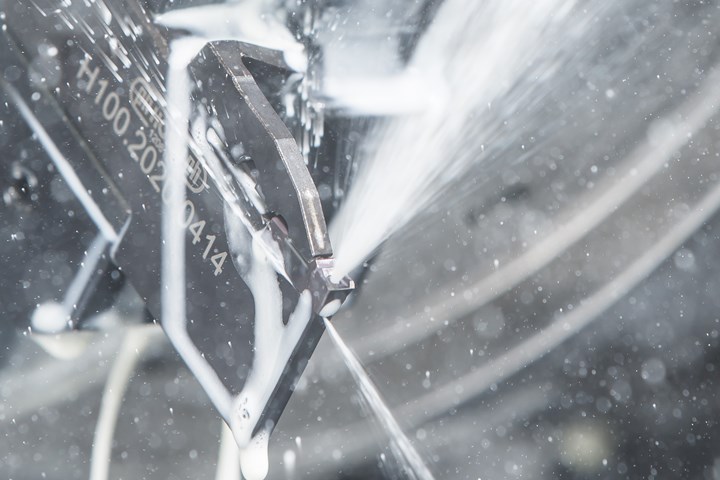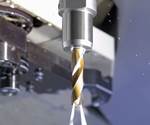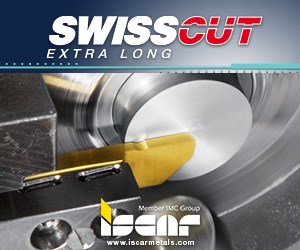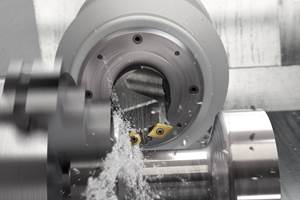Q&A: Trends in Cutting Tool Application
Cutting tool technology is advancing and shops’ needs are changing as well. A leading cutting tool supplier offers this view.
Cutting tool technology is advancing in both subtle and significant ways, and shops’ needs are changing as well. It is worth stepping back to take stock of these two important areas of change for cutting tools — namely, how they are designed and made, and how they are being used.
I recently spoke with John Kollenbroich, head of product management for cutting tool supplier Horn USA, about trends he is seeing. Our conversation was in the “IMTS spark” digital platform. Find the full conversation there. Here is an excerpt:
Modern Machine Shop: In grooving, turning and part-off tools, you are seeing more demand for tools providing coolant through the tool. There are a couple factors here we’ll talk about: more recognition of the need for this, plus a technology change in this tooling. First, why is through-tool coolant valuable, and why do you think shops are seeing greater need for it?
John Kollenbroich: Getting coolant to the cutting edge is critical for any manufacturing application. It helps in cooling the cutting zone, provides very needed lubrication, and can assist in breaking a chip. Many times, external lines are used to splash coolant near the work zone. Long Chips can easily interfere with this delivery method, possibly knocking the lines out of the way. Additionally, when tools need to be changed or indexed coolant lines might be moved for better access to the tool. Then when the line is put back it is never the same as it previously was. Often times there is a give-and-take methodology used to cover areas being machined with this coolant, so all tools get some cooling, but none of them get ideal cooling. A coolant-through tool allows pinpoint accuracy with a specific direction of coolant pointed exactly at the cutting zone. This coolant supply is typically not affected by chip production, and occasionally, if high pressure is used, it can aid in breaking the chip. We also have applications where the coolant-through tool has shown marked improvement in tool life.

Small-diameter drilling, and effective use of this during tool manufacturing, has brought precise through-tool coolant to smaller turning tools. Photo Credit: Horn
MMS: Through-tool coolant is available on cutters that couldn't offer it before. What has changed in the technology of tool manufacturing to make this possible?
JK: There’s been a big change is the ability to drill small-diameter holes very deep and do this in a production atmosphere. Part of this comes from the drilling machines being able to reach the necessary speeds and holders that provide superior clamping and runout. The other part comes from tools designed specifically for this drilling application. There are cases in manufacturing our tools where we are working with holes around 1 to 1.5 mm in diameter and 10 to 20 diameters deep. We’ve learned to design to take advantage of this. On a coolant-through tool, material could be added in areas that may need additional strength, allowing for the intersecting coolant ports to be drilled accordingly.
MMS: On machining centers in particular, speed is still increasing. Maybe the top speed available to machining center spindles hasn't changed all that much, but the use of higher-speed spindles continues to become more common. So, if the top speed hasn't gone up, the average speed in shops certainly has. How are cutting tool offerings responding to this? What aspect of tool engineering is responding to greater cutting speed?
JK: Machines and tools seem to have a back-and-forth dance in terms of which is leading. Currently, I believe cutting tools are in the lead, being able to withstand extremely high surface speed. This is mainly due to coatings and coating technology. Coatings continue to evolve, with more layers, and different material being used. This is something all tool manufactures are playing with on some level. The changes in coating technology is somewhat more limited, and not as many are playing in this arena. One process that comes to mind is “HiPIMS,” or high-power impulse magnetron sputtering. This process uses microsecond timing of extreme-power pulses. This allows the metal to ionize to nano size particles to be deposited on the tools. This process allows for greater adhesion and coating hardness, while maintaining great lubricity. Additionally, this process has greatly reduced compressive stresses. This reduction allows for smaller edge preps to be used, thus resulting in sharper tools. Think of compressive stresses as something pulling in all directions at the same time. If these stresses are pulling on a sharp edge it can pop the carbide right off. In order to circumvent this issue, edge preps are put on the tool. Basically, honing the edge, which is dulling the tool slightly. All tooling manufacturers must do this to properly support the coating. With HiPIMS you can have much smaller edge preps, and thus a sharper tool, for more free machining. Having a sharper tool allows for longer tool life. In testing against ourselves we have seen improvements of 50% using the HiPIMS coating technology.

Accessories for quick-change tooling might deliver more cost savings than incrementally faster cutting speed can, because to much productivity is potentially lost in changing out tools. Photo Credit: Horn
MMS: Here is a topic that does not directly relate to the cutting edge, but still can connect to significant time savings: setup time. You are seeing something related to quick-change tooling and its adoption.
JK: Yes. Improvements in tool life add up. The increase allows for lower cost per part, but most of the time, these saving amount to limited returns. One of the reasons for this limiting factor is tool change time. This is a loss of machining time. Sometimes this loss is small, say 5 minutes to change a tool, other times it can be very large, say 30 minutes or more. If you are able to implement quick-change tooling, and consistently swap out new tooling in 1 to 2 minutes, your savings add up quickly. Swiss-style machines are one area where the saving can be very large. A typical insert change on a Swiss-style machine can be 15 minutes per tool. If you are changing out three tools per shift, that’s 45 minutes of non-production time. Now look at quick-change times of 2 minutes, 3 times a day, and you are at 6 minutes. That almost 40 minutes of production you have gained back. Considering a typical machine rate of $100, you just saved $65 that shift. Do that over a week, two shifts per day, and you have gained back almost 400 minutes, or one free shift of production. This could be the difference between needing to add equipment or better utilizing the machines you have.
MMS: Setup time reduction is a way to increase available machining capacity. Another important way that a growing number of shops is exploring is lights-out machining. The cutting tool plays a role here. What is the way to think about tools in unattended machining?
JK: Lights-out machining is a concept that many companies employ, but not all of them are successful. Sometimes there are only certain jobs that can be run due to issues within the machine. Sometimes shops slow down their tools in an attempt to increase tool life, hopefully reaching a full unattended shift. This is not always the correct approach. Tools are developed to cut within certain parameters, and tool life becomes predictable only within the proper window of operation. Once you have predictable tool life, regardless of time in the machine, you can begin to consider unattended operation. Also, another reason for running tools within the proper parameters is chip control. When a tool is underfed, many things can happen. You could be getting premature wear because of more rubbing than cutting, and you could be creating more of a stringy chip that could block coolant flow or cause issues for other tools.
Related Content
Sumitomo Offers Quick-Change System, Chipbreaker for Swiss-Type Machining
The PSZ Turn System offers products for front-turning, grooving, thread-cutting and back-turning applications. Additionally, the MEFF Chipbreaker enables excellent chip control, low cutting force and good surface finish at a range of depth of cuts.
Read MoreHow to Turn Machine Shop Downtime Into Process Expertise
To take advantage of a lull in business, JR Machine devised a week-long cutting tool event that elevated the shop’s capabilities with aerospace alloys.
Read MoreChoosing Your Carbide Grade: A Guide
Without an international standard for designating carbide grades or application ranges, users must rely on relative judgments and background knowledge for success.
Read MoreSandvik Coromant Turning Tools Enable Y-Axis Turning
The company has developed two new tools to support Y-axis turning: CoroTurn Prime and the CoroPlex YT twin-tool.
Read MoreRead Next
From Aggravation to Lights-Out Production
Automated machining has transformed this South Carolina shop. However, achieving unattended production involved far more than just shutting off the lights.
Read MoreQuick-Change Tooling Improves Swiss Lathe Profits
Horn USA has developed quick-change tooling systems to drastically reduce set-up and toolchange times for Swiss-type lathes, including those with through coolant.
Read MoreHow One CNC Machine Shop Embraced Through-Tool High-Pressure Coolant
Instead of flooding the cutting zone with coolant, Burr Oak Tool uses LNS ChipBlaster systems to better control coolant flow and pressure, improving tool life and productivity.
Read More
.jpg;width=70;height=70;mode=crop)













.png;maxWidth=300;quality=90)















